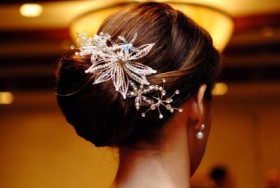Not only is pearl the birthstone for June, but it is also probably the second most important gem for brides next to diamonds. This timeless, classic gem has long been associated with love, beauty, success, happiness and purity. These themes have made pearls the perfect accessory for brides the world over.
In fact, Brides have been wearing pearls on their wedding day for at least 3,000 years. Historians believe the tradition started in Hindu culture. In the Rigveda, an ancient Hindu book dating back to 1000 B.C., Krishna, the preserver, brought forth pearls from the depths of the sea to give to his daughter on her wedding day.
The ancient Greeks also believed that pearls should be part of the wedding experience. They considered pearls to be the “wedding gem” that would help ensure marital bliss and prevent newlywed brides from crying.
During the Crusades, gallant knights returning from the Holy Lands would bestow pearls upon their “fair ladies” for their wedding days.
In the 14th and 15th centuries, pearls were the height of wedding fashion in the French House of Burgundy. During royal weddings, everyone from the bride to her male guests were adorned in glowing pearls.
From the 16th century reign of England’s Queen Elizabeth I to current monarch Queen Elizabeth II, the tradition of wearing pearls on the wedding day has continued. At the beginning of the 20th century, pearls were as much a nuptial gem in the United States as diamonds. Today, brides usually wear pearl necklaces, earrings or bracelets for their big walk down the aisle because their white luster perfectly matches the wedding gown and mirrors its symbolic purity. Often the father of the bride or the groom gives the gift of pearls.
Many brides also incorporate pearls into their gown, from a simply decorated hemline to a fully ornamented bodice. Pearls are also becoming increasingly more important in non-jewelry wedding accessories such as hairpieces, hair combs and other related hair items, handbags, decorated gloves and glimmering shoes.
Pearls also have become the perfect gift for the bridal party. Many brides give pearl jewelry and other pearl items to their bridesmaids, mothers, mothers-in-law, grandmothers and other loved ones.
Incidentally, pearls aren’t just for new brides. They are also the recommended gift for couples celebrating their third and 30th wedding anniversaries.
This elegant, fashionable gem has a surprisingly humble origin. A natural pearl starts out as a grain of sand or a microscopic worm that works its way into an oyster and cannot be expelled. To protect its soft body from this irritant and ease its discomfort, the oyster secretes a smooth, hard crystalline substance called nacre (also known as mother-of-pearl). Layer upon layer of nacre coats the foreign object and hardens, ultimately forming a beautiful pearl. In general, the thicker the nacre, the richer the “glow” of the pearl — which can greatly enhance its value.
Although early pearl gathering depended on divers braving the oceans’ depths to retrieve these treasures, the vast majority of pearls on the market today are grown, or cultured, on pearl farms by surgically inserting a small shell bead, or nucleus, into the mantle of an oyster. It takes several years to raise the oyster and produce a cultured pearl. And even though pearls are harvested en masse on pearl farms, producing a quality pearl is an extremely rare event. It is estimated that half of all nucleated oysters do not survive — and of those that do, only 20% bear marketable pearls.
Pearls are cultured by oysters in salt water and by mussels in fresh water (lakes and rivers). Each mussel can yield up to a 30-pearl harvest — which is one of the reasons why freshwater cultured pearls are less expensive than saltwater cultured pearls. (Another reason is that they are often imperfectly shaped and are typically less lustrous than saltwater cultured pearls.)
This exquisite gem comes in a variety of sizes, shapes and colors, including:
- Akoya pearls — classic round pearls found in most quality pearl jewelry. They are mainly grown in the waters off Japan. They come in a range of hues, including white, cream, pink and peach.
- White South Sea pearls — grown in Australia, Indonesia, the Philippines and other areas of the South Pacific and are prized for their large size.
- Tahitian pearls — grown in French Polynesia, these pearls can be very large and come in a range of natural colors from gray to black to green to purple. Because of their large size and unique dark colors, they command very high prices.
- Mabe pearls — grown in Japan, Indonesia, French Polynesia and Australia. These pearls are usually flat-backed because they form against the inside shell of the oyster rather than within the oyster’s body. They are often used in earrings and rings.
- Freshwater pearls — usually grown in bays, lakes and rivers primarily in Japan, China and the United States. They are often irregularly shaped, of various colors, and are less lustrous than saltwater cultured pearls.
When shopping for pearls, the five factors that determine value are luster (surface brilliance); surface cleanliness (absence of spots, bumps or cracks); shape (generally, the rounder the pearl, the higher its value); color (pearls come many hues); and size (the average pearl sold is 7-7.5 mm, but these gems can be as small as 1 mm or as large as 20 mm. High-quality pearl strands will feature pearls well-matched in these five characteristics.














Stay in Touch